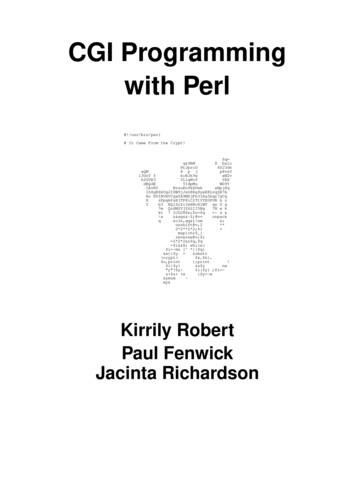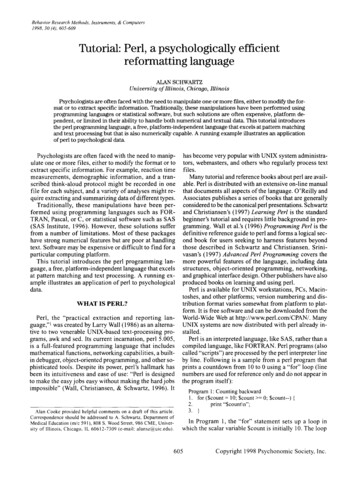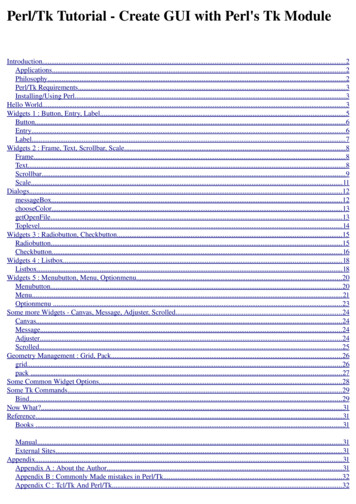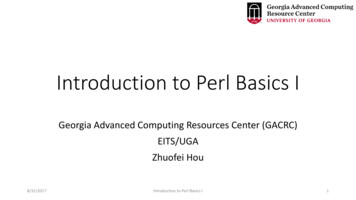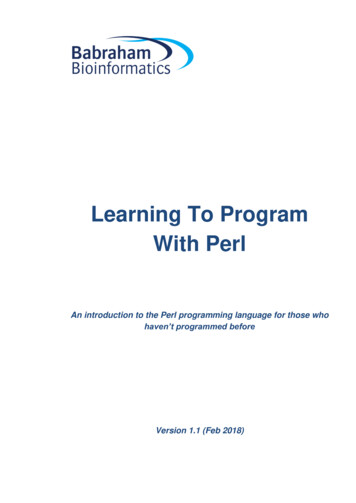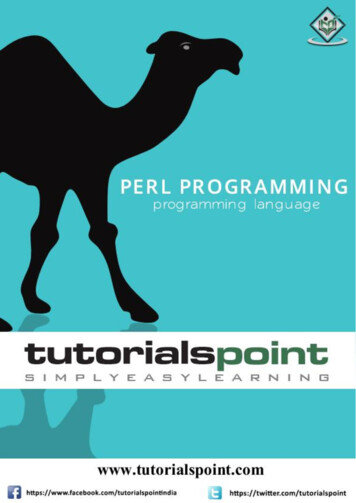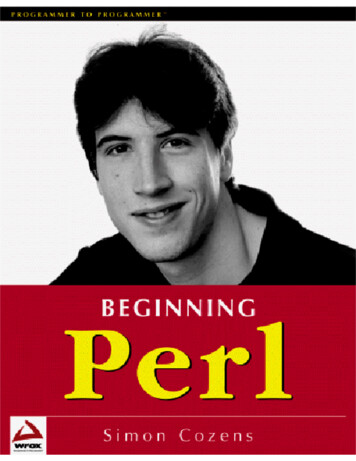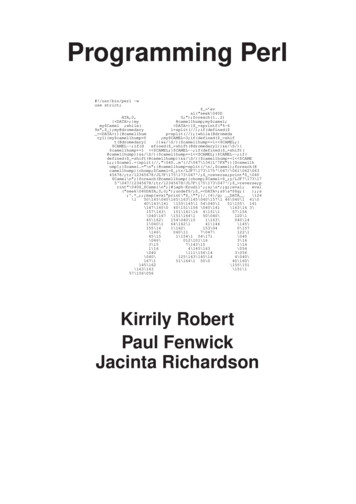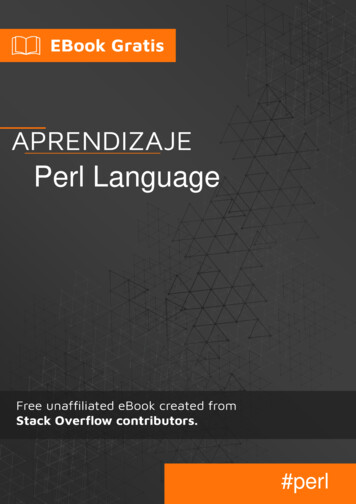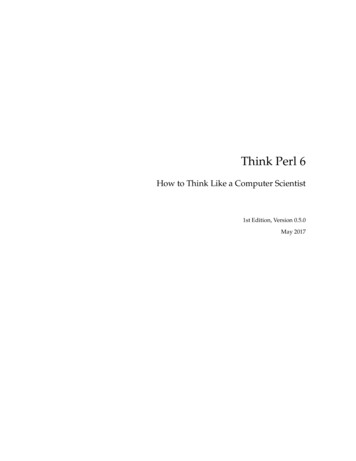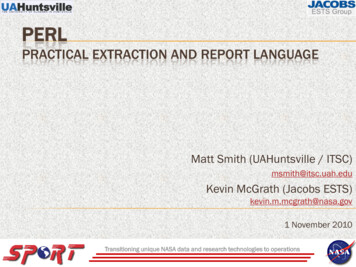
Transcription
PERLPRACTICAL EXTRACTION AND REPORT LANGUAGEMatt Smith (UAHuntsville / ITSC)msmith@itsc.uah.eduKevin McGrath (Jacobs ESTS)kevin.m.mcgrath@nasa.gov1 November 2010Transitioning unique NASA data and research technologies to operations
OUTLINE IntroSyntaxRunning Perl programsPragmasVariablesModulesString manipulationControl structures File manipulationI/ORegular expressionsSubroutines/FunctionsSystem commandsDate/Time manipulationCsh examplesExternal appsTransitioning unique NASA data and research technologies to operations
INTRODUCTION A general-purpose programming language originally developed fortext manipulation and now used for a wide range of tasks includingsystem administration, web development, network programming,GUI development, and more.Intended to be practical (easy to use, efficient, complete) ratherthan beautiful (tiny, elegant, minimal).Major features Easy to useSupports both procedural and object-oriented (OO) programmingHas powerful built-in support for text processingHas one of the world's most impressive collections of third-partymodulesTransitioning unique NASA data and research technologies to operations
WHY PERL? It is a complete programming language!Still – it’s just another wrench in your toolboxSome simple tasks are still QED in c/b/ba/k-shellYou don’t have to compile and create object files and then executeAbility to perform floating-point arithmeticCan still do easy file manipulation, like a shellThere is a MS Windows version, if interestedFewer external commands required (use internal perl functions)A plethora of libraries (modules) are availableTransitioning unique NASA data and research technologies to operations
SYNTAX Leading blank spaces and tabs are ignoredEnd a command line with a semicolon ‘;’Indenting is good practice, and Smart!Variables are case sensitive# Comments, but no multi-line comment syntaxEscape character backslash ‘\’Variables always have prefix character ( , @, %)Kevin McGrath has a suggested documentation template At the SPoRT web siteTransitioning unique NASA data and research technologies to operations
RUNNING PERL SCRIPTS The “Hello world” script:#!/usr/bin/perl –wprint “Hello world!\n”; # hash-bang# SpeakThe first line (starting with the “shebang” ‘#!’ interpreter directive)tells the kernel that this is a perl script and where to find the perlinterpreterThe -w switch tells perl to produce extra warning messages aboutpotentially dangerous constructsNext, we use ‘print’ to print a string (in quotes) consisting ofprintable characters and a newline or linefeed ‘\n’ (0x0A)Note the comments – everything to the right of a ‘#’ on a lineUsually placed in a file with a “pl” extension (e.g., test.pl)An exit is implied, though you can return a status code (exit #;)Transitioning unique NASA data and research technologies to operations
PRAGMAS They turn on/off compiler directives, or pragmasE.g.,use integer;# perform integer mathuse strict;# restrict unsafe constructs. Use it!use strict „vars‟; # strict only for variablesuse strict „subs‟; # strict only for subroutinesuse warnings;# as opposed to no warnings;use constant PI 4*atan2(1,1); # argumentless inline func. There are many pragmasTransitioning unique NASA data and research technologies to operations
VARIABLES for scalars (a single value or string) @ for arrays (list of scalars) E.g., a, Joe54, my nameE.g., @List, @files to read, @months% for hashes (AKA associative arrays or ‘key/value’ arrays) E.g., %mcidas res, %CoinsTransitioning unique NASA data and research technologies to operations
DEFINING AND USING SCALARS name “Bubba Gump”; number 12; avg 3.254; total {amps}**2 volts; name {first}. {last}; Email “msmith\@itsc.uah.edu”; ######a stringan integera floatan expression„.‟ concatenates stringsescape the „@‟All calculations are performed internally using floatsScalars are handled as strings in a string context, and as numbersin a numeric context a 42; answer “The ultimate answer is “ . answer;Transitioning unique NASA data and research technologies to operations
DEFINING AND USING ARRAYS (LISTS)@list (“Gary”, “Steve”, “Bill”);@ListOfNumbers (1.100);@odd (1, 2, 12.34, “Bob”);@empty ();####stringsindex generatorodd but finearray w/ 0 elementsAccessing arrays is C-like – using brackets [ ] – and they’re 0-based.Use when dealing with one element of an array. odd[2] contains 12.34They will grow to accommodate new elements. So, stations[99] 1000; # generates a 100 element arrayWhen used in a scalar context, an array evaluates to its length. So, length @stations;# length is now 100Transitioning unique NASA data and research technologies to operations
DEFINING AND USING HASHES%coins (Quarter 25, Dime 10, Nickel 5);my name “Dime”;my total coin{ name} coin{Nickel};now contains 15Multidimensional hashes total my %goes (vis {band 1, res 1, loc “GHCC GE/VIS”},wv {band 3, res 4, loc “GHCC GE/IR3”});my channel goes{vis}- {band};print “GOES-East WV has a res of goes{wv}- {res} km\n”;Transitioning unique NASA data and research technologies to operations
SCOPE Normally, every variable has a global scope. Once defined, everypart of your program can access a variable.When variables are declared with my(), they are only visibleinside the code block. Any variable which has the same nameoutside the block is ignored. name “Rover”; pet “dog”;print “The pet is named name\n”;# The dog is named Rover{my name “Spot”;# local instance of name pet “cat”;# overwrites pet defined aboveprint “The pet is named name\n"; # The cat is named Spot}print “The pet is named name\n";# The cat is named RoverTransitioning unique NASA data and research technologies to operations
SCOPE (CONT’D) When the use strict pragma is used (highly recommended) Each variable must be declared with either my or our Declaring variables using our expands their scope beyond theblock in which they are defined Variables must be declared with our if you wish to make themvisible to subroutines. The variables then must be “imported”into your subroutines (more on that later).Transitioning unique NASA data and research technologies to operations
MODULES Modules expand the number of available functions (in addition tothose “built-in”)Near top of code, list modules to use, using this syntax:use module::name; The Comprehensive Perl Archive Network (CPAN)http://www.cpan.org/ has a huge list of documented modules thatare publicly available.Example:use File::Copy;copy file1, file2;move file1, file2; Many functions that serve as wrappers for syscalls return true onsuccess, and undef on failure.Transitioning unique NASA data and research technologies to operations
MORE MODULES Some modules are not already installed and require installation bySysAdminExample modules:useuseuseuseuseuseuseuseMath::Trig; # tan, cos, sin, acos, asin, pi, deg2rad, etc.Statistics::Basic; # median, mean, variance, stddev, etc.File::Basename; # basename, dirnameImage::Magick; # read, crop, contrast, draw, etc.GD; # rectangle,transparent, colorAllocate, Font, etc.NetCDF; # open, varget, varput, close, etc.Net::FTP; # FTP functionsPDL::IO:? # various Perl Data Language I/O modulesFITS, GD, Grib, HDF, HDF5, IDLTransitioning unique NASA data and research technologies to operations
STRING MANIPULATION Strings can be stored in any variable type (scalar, array, and hash).Enclosed in “quotes” ( or @ variables are evaluated at run-time)Enclosed in ‘apostrophes’ ( or @ variables are NOT evaluated)Dot operator “.” concatenates stringsRepetition operator ‘x’ repeatsUse eq/ne/lt/le/gt/ge for string comparisons (not /! / / / / )Special operators and ! (later) name first . “ “ . last; fourSixes “6”x4; # gives “6666”@fours (“4”)x4;# gives a list (array): (“4”, “4”, “4”, “4”)if ( name eq “Smith”) { match 1; }Transitioning unique NASA data and research technologies to operations
STRING MANIPULATION (CONT’D) Concatenating and adding strings and numbers a 1; b “hello”; c a. a; # c 11 c a b; # c 1 c a. b; # c “1hello” c b b; # c 0 (treats(*hello(treats(*hello1 as “1”)isn‟t numeric*)1 as “1”)isn‟t numeric*)Leading blanks and trailing non-numerics are ignored“ 123.45tom” becomes 123.45Functions that expect a numeric will interpret strings as 0undef is interpreted as 0Transitioning unique NASA data and research technologies to operations
STRING MANIPULATION (CONT’D) lc(“Hello”) returns“hello” (lowercase)uc(“Hello”) returns “HELLO” (uppercase)Most string input from STDIN (standard input) and other readfunctions end with a newline. This WILL bite you! To remove it,use chomp:print “What is your name?\n”; name STDIN ;chomp( name);Note:STDIN Standard InputSTDOUT Standard Output,STDERR Standard ErrorTransitioning unique NASA data and research technologies to operations
STRING MANIPULATION (CONT’D) How to tell if a variable is a number?Use an external function in a module (“looks like number”)use Scalar::Util „looks like number‟;print “Enter a number: ”;while (! looks like number( STDIN )) {print “Not numeric, try again: ”;}Transitioning unique NASA data and research technologies to operations
SPLIT/JOIN @array variable split(/separator/, string);my data “Becky Windham,25,female,Madison”;my @values split(/,/, data);values[0] contains “Becky Windham”values[1] contains 25values[2] contains “female”values[3] contains “Madison” If no separator is given, / / (space) is assumedIf no string is given, is assumedRegex examplemy @pieces split(/\d /, data); # split on one or more digitsTransitioning unique NASA data and research technologies to operations
CONTROL STRUCTURES: IF Very similar to csh and C.missing “e” in elsif.elsif and else areoptional. Note the month date %m ;chomp( month);if ( month 1) {print “The month is January.\n”;} elsif ( month 2 month 3) {print “It‟s February or March.\n”;} else {print “It‟s after March.\n”;} and and && areinterchangeable, as are or and Transitioning unique NASA data and research technologies to operations
CONTROL STRUCTURES: WHILE & DOprint “How old are you? “; a STDIN ; chomp( a);while ( a 0) {# note optional use of parenthesesprint “At one time, you were a years old.\n”; a--;} The opposite of while is untildo is similar to while, except that the expression is evaluated at theend of the block. The contents of the do block will be executed atleast once. day 0;do { day ;print “Processing data for day: day.\n”;} while day 10;# note optional lack of parenthesesTransitioning unique NASA data and research technologies to operations
CONTROL STRUCTURES: FOR/FOREACHfor ( i 1; i 10; i ) {print “ i\n”; }for ( j 0; j 100; j 5) {print “ j\n”; }@a (1.4);foreach (@a) { square ** 2;# default loop variableprint “The square of is square\n”; }@a (1,2,3,4);foreach number (@a) { square number * number;print “The square of number is square\n”;}Transitioning unique NASA data and research technologies to operations
CONTROL STRUCTURES is similar to break statement of C. Whenever you want to quit from a loop.To skip the current loop use the next statement. It immediately jumps to the next iteration of the loop.The redo statement is used to repeat the same iteration again.lastTransitioning unique NASA data and research technologies to operations
DIE/WARNdie throws an exception – printing a message to STDERRopen( file, “ tempfile”) or die “error opening tempfile\n”; doesn’t throw an exception, but still prints a messageThis code:warnif ( T ob limit-2) {print “Temp T ob near limit\n”;} can be written as:( T ob limit-2) or warn “Temp T ob near limit\n”;#Note: „if‟ implied in usage with warn or dieTransitioning unique NASA data and research technologies to operations
OPEN/CLOSE FILES open FILEHANDLE, MODE, “filename”ModeOperandCreateTruncatexRead Write xAppend xRead/write Read/write Read/append xxxopen LOGFILE, “ log.txt” die “Cannot open log.txt!”; To print to a file, use print FILEHANDLEUse close(FILEHANDLE) to close a file“ “;Transitioning unique NASA data and research technologies to operations
FILE MANIPULATION Use unlink to remove files. Returns 1 if successful, 0 if unsuccessful.unlink(“sample.txt”, filename, “ dir/ user/tempfile”);unlink glob(“2010 11*”);unlink *.gif ;# quotes optional with foreach ( *.gif ) {unlink warn “I‟m having trouble deleting ”;}rename “file23”, new file;# if you only want to rename To copy or move a file use File::Copy;copy “log.txt”, newFile;move file, “ {SPoRT ADAS DIR}/ newfile”;Transitioning unique NASA data and research technologies to operations
FILE AND DIRECTORY TESTS To test if a file or directory exists, usea true-false condition.Other useful tests:File Test-eMeaningif (-e filename).File TestReturnsMeaningFile or directory is exists-lEntry is a symlinkFile or directory isreadable/writable-TFile is “text”-zFile exists and has zero size-BFile is “binary”-sFile exists and has nonzero size-MModification age in days-dEntry is a directory-AAccess age in days-r, -wTransitioning unique NASA data and research technologies to operations
FILE STATUS To get detailed information about a file, call the stat function.Time is in seconds since the epoch and size is in bytes.( dev, ino, mode, nlink, uid, gid, rdev, size, atime, mtime, ctime, blsize, blocks) stat( fileName);or( size, mtime) stat( fileName)[7,9]; The File::Stat module is a by-name interface to the stat function:use File::stat; status1 stat( fileName1); status2 stat( fileName2); ageDiff status2- mtime - status1- mtime;print “ fileName2 is ageDiff seconds older than fileName1”;Transitioning unique NASA data and research technologies to operations
READING TEXT FILES To read a text file line-by-line, you can use:my @lines FILEHANDLE ; Alternatively, you could process the file line by line using while ( FILEHANDLE )) {print “Processing ”;}orwhile (my line FILEHANDLE ) {.} Remember you may want to chomp each line!Transitioning unique NASA data and research technologies to operations
TERMINAL INPUT STDIN can be abbreviated by using simple . By declaring ascalar variable and setting it equal to STDIN we set the variableequal to whatever will be typed by a user at the command prompt.print "What is the radius of the circle? "; r ;# chomp not required in numeric context diameter (2 * r); area (3.14 * ( r ** 2)); cir diameter * 3.14;print “ Radius: r\n Diameter: diameter\n Circumference: cir\n Area: area";Transitioning unique NASA data and research technologies to operations
COMMAND LINE ARGUMENTS Command line arguments are stored in the @ARGV arrayAccess the elements as you would any other array ( ARGV[0]) #ARGV to examine the size of the arrayExample code:my channel ARGV[0] die “No argument passed!\n”;print “Processing GOES channel data \n”; } Executing the code:cmd goesImager.pl IR Returns:Processing GOES IR data Transitioning unique NASA data and research technologies to operations
BINARY I/Omy val;#my @r, @g, @b;#open(OUTP, “ output.fil”); #binmode OUTP;#. . .# val pack('L', 0x80808080);#print OUTP val;# val pack('N256', @r);#print OUTP val;#. . .#. . . val pack('N48', 0);#print OUTP val;#scalar for storing dataarrays for r, g, bopen output fileplace OUTP in binary modefill RGB arrays with 256 valuespack McIDAS missing data valuewrite to OUTPpack values into Red arraywrite Red array to OUTPpack & write G & B arrayspack 48 Reserved words - emptywrite to OUTPTransitioning unique NASA data and research technologies to operations
PRINT/PRINTF number "5"; string "Hello, PERL!"; float 12.39; ddd 9; nothing undef;# assign an empty (undefined) valueprint " number\n";# 5print " string\n";# Hello, PERL!print " float\n";# 12.39printf "Value:%8.4f\n", float;# Value: 12.3900 doy sprintf ("%03d", ddd);print "Day of Year doy\n";# Day of Year 009print "There is nothing: nothing\n";# There is nothing:Transitioning unique NASA data and research technologies to operations
REGULAR EXPRESSION EXAMPLES Complex string comparisonsif ( string m/sought text/) # m is the "match" operator.Complex string selectionsif ( string m/whatever(sought text)whatever2/) soughtText 1; Complex string replacements string s/originaltext/newtext/; # s is the "substitute"operator. Parsing based on the above abilitiesif (“20100501 T 212.grib” m/ 20100501 (.) 212.grib /)Transitioning unique NASA data and research technologies to operations#true
SUBROUTINES/FUNCTIONS sub NAME BLOCK Use all lower case names (suggestion)BLOCK is code within braces { }Arguments may be passed print greeting(“The year is”, 2010);sub print greeting { string [0]; year [1];print ” string year\n”;}# Grab passed arguments# Prints “The year is 2010”Transitioning unique NASA data and research technologies to operations
SUBROUTINES/FUNCTIONS An our declaration declares a global variable that will be visibleacross its entire lexical scope, even across package boundaries. Touse global variables in a subroutine while using strict, you must“import” them.#!/usr/bin/perl –wuse strict;{ our name "Kevin";our office 3031;printinfo();# Call subroutine printinfo}sub printinfo {# Use the following variables defined in the main blockuse vars qw( name office); # Or use vars (“ name”, “ office”);print “ Name: name\n Office: office\n“;}Transitioning unique NASA data and research technologies to operations
SYSTEM COMMANDSThere’s more than one way to skin a cat. System command (returns command status) stat system(“mv out.dat /tmp/junk”); Backticks (returns command’s output) output imglist.k GHCC GE/IR4 grep “18:45” ; Many Perl methods can replace system commands@list *.dat ; # Use instead of @list ls *.dat Some security risks exist with non-Perl system callsTransitioning unique NASA data and research technologies to operations
DATE / TIME MANIPULATION use Date::Manip; # full set of functions (quicker subsets exist) ddd Date DayOfYear( mm, dd, yyyy); Default date format is yyyymmddhh:mm:ss date ParseDate(“2nd Sunday in 2011"); # returns yyyymmddhh:mm:ss date ParseDate(“39 minutes ago");# returns yyyymmddhh:mm:ss future DateCalc( date, “12 hours later");# 12 hours from date past DateCalc( date, -30:00:00);# 30 hours before date(Did you know that the Unix date command can act similarly?) Determine delta between two dates/times diff DateCalc( date1, date2); # Returns “y:m:d:h:m:s” Increment a date/time Use/convert/compare almost any date/time formatTransitioning unique NASA data and research technologies to operations
CSH EXAMPLES Environment variables Getting path ENV{“PATH”}; Setting ENV{“PATH”} path . “:/home/kmcgrath/mcidas/data”; Running external Perl scriptsdo “/data/user/setEnv.pl” die “Error\n”; Change working directorychdir( dataDir);Transitioning unique NASA data and research technologies to operations
FTP EXAMPLEThe Net:FTP module implements a simple FTP client in Perl. Methodsreturn true or false to indicate operation success.use Net::FTP; ftp Net::FTP- new(“ssd.nesdis.noaa.gov”, Passive 1); ftp- login( ftpUser, ftpPassword); ftp- binary(); ftp- get( remoteFile, localDir/ file) die “get failed ” . ftp- message; ftp- quit();Transitioning unique NASA data and research technologies to operations
MCIDAS EXAMPLEYou can execute many McIDAS commands as system commands (e.g.,imglist.k) and gather output returned, but screen manipulation (e.g.,FRMSAVE) requires a McIDAS session – via mcenv.Note: McIDAS commands need POSITIONAL PARAMETERS andKEYWORDS to be in all-caps, but not the executable name itself.) output mcenv -f 600x844 -e 10m -g 8 -i 240 EOCimgdisp.k GHCC GE/IR4 MAG -1 -2 LAT lat lonmap.k VHfrmsave.k X gifName FORM GIFexitEOC ;print output;Transitioning unique NASA data and research technologies to operations
EMAIL EXAMPLE#!/usr/bin/perl -wmy recipients "msmith\@itsc.uah.edu kevin.m.mcgrath\@nasa.gov";my subject "Perl test";my product “LIS 12-Hour Forecast”;my status /bin/mail -s " subject" recipients EOFThis is the body of the email.The product isn‟t updating.EOF ;if ( status ne "") {print "error with mail\n";exit 1;}Transitioning unique NASA data and research technologies to operations
WEB SITES FOR .orgwww.tizag.com/perlTTransitioning unique NASA data and research technologies to operations
#!/usr/bin/perl –w # hash-bang print “Hello world!\n”; # Speak The first line (starting with the shebang #! interpreter directive) tells the kernel that this is a perl script and where to find the perl interpreter The -w switch tells perl to produce extr
